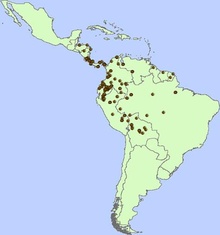User:Felix sadlo/sandbox
Ecology
[edit]The peach palm grows wild in well-drained soils with various physical and chemical conditions, including acid and poor soils, since it is assisted by its association with mycorrhizas. It is grown in climates with precipitations between 2 000 mm and 5 000 mm and annual mean temperatures exceeding 24°C. The recommended altitude for commercial cultivation ranges from 0 to 900 m asl [1]. Peach palm is occasionally found at higher altitudes of up to 1800m asl, as the case in Columbia`s Cauca region El Tambo [2].
Peach palm can be considered the most important domesticated palm species of the Neotropics. Its wild and domesticated populations can be found in Central America, in the pacific lowlands of Columbia and Ecuador, in Venezuela and in the area of the Amazon rainforest, especially at the eastern foothills of the Andes. The exact origin of the cultivated peach palm remains open to debate The widespread cultivation of peach palm in the Americas reflects its capacity to adapt to a wide range of ecological conditions in the Tropics and Subtropics [2].

Wild and cultivated peach palm populations are genetically very diverse and could offer useful traits for breeding [3]. Genetically the peach palm can be divided into (a) two western populations including Central America, the Andean valleys of Columbia and Venezuela and the pacific lowlands of Columbia and Ecuador; and (b) two western populations including the upper and the eastern Amazon. In general the western populations have harder stems, more abundant and stronger spines, larger leaves and more solid rooting in their juvenile phase [1].
Peach palm is a predominantly outcrossing species, though self fertilization has also been observed. Pollination is carried out mainly by insects, especially by small curculionid beetles over distances between 100 and 500 m. Wind and gravity can also function as pollen vectors. Since peach palm is a long-lived perennial and predominantly outcrossing species the genetic diversity of the populations is high. Though no definite studies have been conducted on seed dispersal of peach palms, it is probably restricted locally to dispersal by birds and seed-gathering mammals. Seeds may only be occasionally dispersed by water of greater distances. The gene flow of outcrossing tree species with such scattered distribution may be restricted and could result into genetically distinct, isolated subpopulations with small effective population sizes [1]. In contrast to the cultivated peach palm, wild populations are threatened by deforestation, driven mainly by agricultural expansion and the transition of forest to savannah. Many populations are now isolated by increasing forest fragmentation, which will lead to decreased reproduction via inbreeding depression and eventual extinction even without complete deforestation [4]. Their natural distribution is not yet well defined. Wild peach palm trees can be found in disturbed ecosystems, on river banks and in primary forest gaps. They often occur in isolation or at low densities [1].
- ^ a b c d Mora-Urpi, J. (1997). "Peach palm. Bactris gasipaes Kunth. Promoting the conservation and use of underutilized and neglected crops. 20. Institute of plant Genetics and Crop Plant Research". Gatersleben/IPGRI, Rome.
{{cite journal}}: Cite journal requires|journal=(help) - ^ a b Graefe, Sophie (2013). "Peach palm (Bactris gasipaes) in tropical Latin America: implications for biodiversity conservation, natural resource management and human nutrition". Biodiversity and Conservation: 269–300. doi:10.1007/s10531-012-0402-3.
- ^ Araujo, CM (2010). "Genetic variability in the peach palm gene bank with rapid RAPD markers". Crop breed and Applied Biotechnology 10: 211–217.
- ^ Clement, CR:; et al. (2009). "Ecological adaptation of wild peach palm, its in situ conservation and deforestation-mediated extinction in southern Brazilian Amazonia". PLoS One: 4:e4564.
{{cite journal}}: Explicit use of et al. in:|first=(help)

